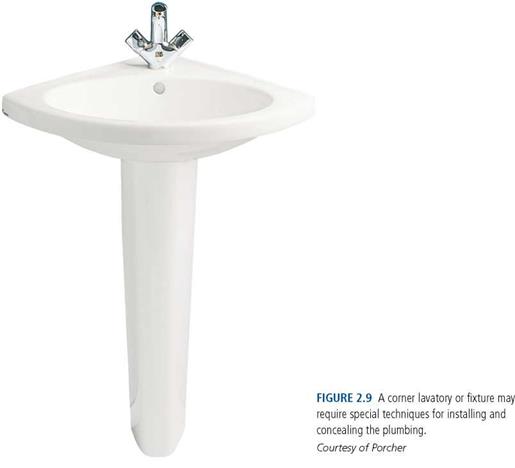A new bathroom means selecting all new fixtures, but when a client is remodeling a bathroom they can make choices as to which fixtures they replace. If cutting costs is a goal, some of the fixtures may be able to be reused, especially if they have been replaced fairly recently. If the client chooses to keep some of the present fixtures, can they be successfully removed and relocated if the new plan called for a new location? Refer to Form 10 in chapter 5, "Assessing Needs" to collect information and measurements on existing fixtures and water-using appliances.
When new fixtures are desired, will they be able to be installed using the old plumbing or will new lines need to be added? This is discussed in more detail below. Another consideration with new fixtures is their fit in the old spaces. If the basic structure of the bathroom will stay, and the desire is to update the fixtures and look, work with your client to select fixtures that will fit in the old spaces with minimal changes. For example, find a new shower or tub to fit the previous space, or install a new lavatory into a vanity cabinet and counter the client wishes to reuse. With the use of many new finished wall materials, you may even be able to convert a tub space to a shower and vice versa. For tubs, showers, or lavatories, if you decide to relocate the water controls to the counter or wall, or offset for easier access, are there major problems with doing so? For a new or remodeled bathroom project, talk with the client about the fixtures they have in mind, and the basic water and plumbing requirements for each. As an example, keep in mind that the type and location of pedestal lavatories or above-counter vessel bowls have specific requirements for drainpipes or wall-mounted faucets. Corner designed fixtures, especially lavatories and toilets may also have special requirements (see Figure 2.9).
|
|
Another key consideration is water usage. Be sure to select low-flush toilets, low-flow shower – heads, and other water-conserving WaterSense® plumbing fixtures. Using these water-efficient fixtures may solve or avoid some of the problems or concerns related to high water-demand fixtures and the client is incorporating sustainable measures as well. See chapter 3, "Environmental and Sustainability Considerations," for more information on water conservation and other water issues.
You should always discuss the implications of the client’s fixture choices. Larger tubs and high-volume showers can use a tremendous amount of water, which will increase water bills. Also, in order to provide a sufficient spray for massaging showers, a specific water pressure level must be maintained, which may be an issue with some water systems.




